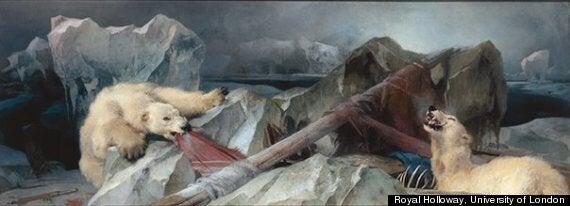Edwin Landseer was an English painter who died in 1873. So why is one of his paintings, depicting a doomed Arctic expedition, still haunting students at a London university more than 140 years later?
Man Proposes, God Disposes is an oil on canvas painting dating from 1864, which has been hanging in the picture gallery at Royal Holloway College, University of London ever since the institution was founded in 1886.

Edwin Landseer's eerie Man Proposes, God Disposes
The college's founder, Thomas Holloway, bought the painting for his women's college in the late 1800s a rather unusual choice, perhaps, considering the context and grisly subject matter.
In a talk earlier this year, the university's curator Dr Laura MacCulloch explored the macabre history of the painting, as well as explaining where the spooky superstition originated.
"I don't know where the rumour started, or when, but for a long time it has been told that this painting is bad luck and if you sit in front of it during your exams you will fail them.
"We think the rumour started in around the 1920s or 30s and even students in the 1960s said they felt it was bad luck."
The painting of the polar bears devouring human remains against the background of a wrecked ship was based on the disappearance of Sir John Franklin and his two Royal Navy vessels in 1845. Franklin and his 129 men were trying to chart the Northwest Passage in the Canadian Arctic when they perished - and the failed expedition became one of the biggest mysteries of all time.
Various rescue efforts took place after the ships went down. In 1854, explorer John Rae spoke to the local Inuit community who had met some of the remaining crew after they had abandoned their ships - and who found the bodies of these men the following year. Following the discovery of the remains of some of the dead sailors, the Inuits believed the bones showed signs of cannibalism - although at the time, horrified Victorians refused to believe the reports.
In a letter to his employer, the Hudson's Bay Company, Rae wrote: "From the mutilated state of many of the bodies and the contents of the kettles, it is evident that our wretched Countrymen had been driven to the last dread alternative - cannibalism - as a means of prolonging existence."
Last week the wreckage of one of the doomed vessels was finally discovered by Canadian divers - more than 160 years after it went down.
Experts believe the crews abandoned their ships in a bid to find help after both of vessels became locked in ice near King William Island.
Three crewmen were discovered in the 1980s, almost perfectly preserved in their icy graves - and experts say the Inuits were correct in their cannibalism theory.
In the 1970s, the painting was so notorious one student refused to sit next to it, according to MacCulloch. So the registrar of the university was called and she decided to get a Union Jack flag to cover the painting.
To this day, the picture is still covered with the flag - just in case.
"The rumour got even bigger and then became that a student had looked at the painting during his exams, gone mad, and then committed suicide. I want to reassure you that as far as we know, we have not found any record of death in the picture gallery."
One graduate told the BBC she had been informed the student had stared directly into one of the polar bears' eyes. The student then went mad and killed herself, not before writing "The polar bears made me do it" onto her exam paper.
Warning: some readers may find the video below disturbing